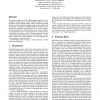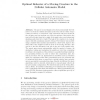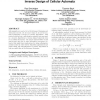269 search results - page 24 / 54 » Computing with Probabilistic Cellular Automata |
SASO
2008
IEEE
14 years 3 months ago
2008
IEEE
—When programming a spatial computing medium such as a cellular automaton, the hop count distance to some set of sources (particles) is an often used information. In particular, ...
CA
2003
IEEE
14 years 1 months ago
2003
IEEE
We present a simple, linear 3D cellular automata approach for animating the melting process of solid volumetric models. Accurate modelling of object melting usually requires compl...
PACT
2005
Springer
14 years 2 months ago
2005
Springer
The goal of our investigation is to find automatically the best rule for a cell in the cellular automata model. The cells are either of type Obstacle, Empty or Creature. Only Crea...
ISVLSI
2006
IEEE
14 years 2 months ago
2006
IEEE
Abstract— Research in the fields of physics, chemistry and electronics has demonstrated that Quantum-dot Cellular Automata (QCA) is a viable alternative for nano-scale computing...
GECCO
2008
Springer
13 years 9 months ago
2008
Springer
Self-adaptation is used a lot in Evolutionary Strategies and with great success, yet for some reason it is not the mutation adaptation of choice for Genetic Algorithms. This poste...



